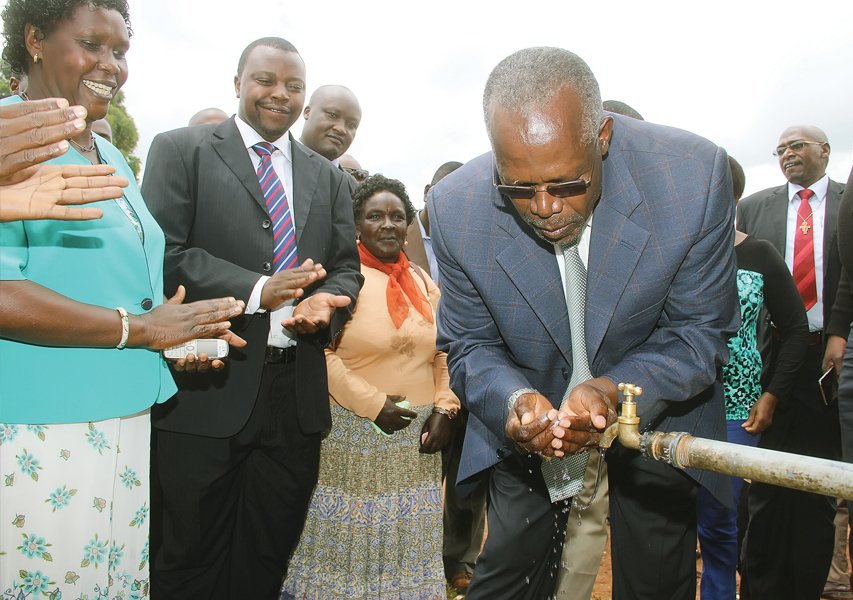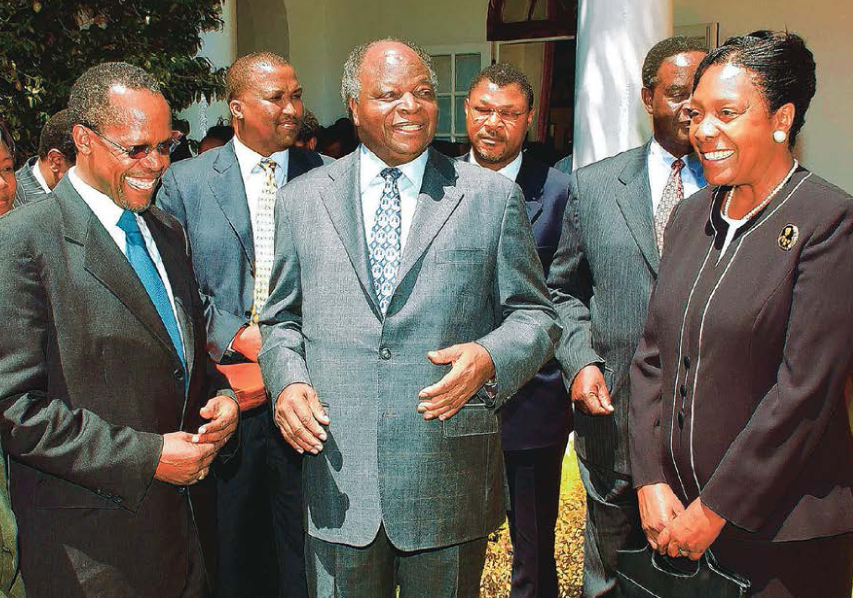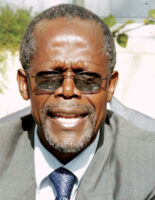
Musikari Nazi Kombo was a Form Six student at Nyeri High School in 1966 when his class invited newly-appointed Minister for Commerce and Industry, Mwai Kibaki, to give a lecture at the school. The topic was the much-acclaimed blueprint on Kenya economic growth, the Sessional Paper No. 10 of 1965. Delivering the lecture, Kibaki was at his oratorical best, giving facts and figures without the aid of written notes. He was spellbinding and left his listeners awed by his mastery of the subject and brilliance of his delivery. There and then, young Kombo resolved to emulate Kibaki by studying economics at the university, and maybe one day get appointed to the Cabinet. Kombo’s high school dream was fulfilled 37 years later, in November 2004, when President Kibaki appointed him Minister, first in the Ministry of Regional Development and then Local Government. The number one credential in Kombo’s curriculum vitae when he joined the Cabinet was his attitude towards corruption, which fitted well with President Kibaki’s agenda – one of his campaign pledges had been to combat corruption gone wild during the previous regime’s 39-year grip on power.
Elected to Parliament on a FORD-Kenya party ticket in 1992, Kombo had established himself as an almost one-man crusader against corruption. With mounting local and international pressure to rein in graft, the previous government, under the Kenya African National Union (KANU) party, had in the mid-1990s established a State- controlled agency purportedly to fight corruption. It was headed by John Harun Mwau, a presidential appointee and business ally of State House mandarins.
Kombo was the first to denounce KANU’s move as mere window-dressing and argued in Parliament that only an independent and constitutionally protected outfit could be trusted to fight corruption in the country. Questions were also raised about Mwau’s personal integrity. To save face, the KANU government made a quick about- turn and came up with the Prevention of Corruption Act. Once again Kombo led the opposition to the proposed Act, which was widely perceived as yet another half-baked measure by KANU intended to hoodwink international development partners into believing that something was being done to tackle corruption in the country.
Kombo and like-minded colleagues in the Opposition came up with radical amendments to the government bill, resulting in the formation of the Kenya Anti- Corruption Authority, which would later mutate into the Kenya Anti-Corruption Commission. Today it is known as the Ethics and Anti-Corruption Commission. But Kombo wasn’t yet done with the lords of corruption. As chairman of the Parliamentary Public Accounts Committee, he oversaw the extraction from the reports of the Auditor General of all cases of stolen public funds and compiled them into one report that was famously referred to as the Kombo List of Shame. With lengthy appendices and annexes on who had stolen what, the report reads like an encyclopedia on graft in Kenya!
Kombo would further champion the fight against corruption in the political arena. He is credited with advocacy that caused enactment of the Political Parties Act 2011, which provided a framework for the registration, regulation and funding of political parties. He is also acclaimed for his contribution to the formulation of policy and charters on anti-corruption elsewhere in Africa and the Caribbean when he served on the board of the African Caribbean and Pacific Group of States-European Union (ACP-EU) bloc.
During an interview for this book, Kombo disclosed another aspect of Kibaki’s development agenda which, unfortunately, never saw the light of day. According to the former Minister, the President did not support the creation of 47 counties under devolution based on ethnic and political considerations. Instead, he wanted just 10 to 15 regional blocs anchored on economic viability and national cohesion. Kombo remembered Kibaki cautioning the Cabinet during a conference that it would be ill-advised to split the country into small units that were economically unviable just to serve the parochial interests of the political elite. For instance, he wondered why Murang’a, Nyeri, Kirinyaga, Embu, Meru and Tharaka Niithi should be independent units when they had common and shared economies and it would make better sense to constitute them as one regional bloc that would benefit from economies of scale! And why not the same for Kisumu, Siaya, Homa Bay and Migori, or Mombasa, Kwale, Kilifi and Taita Taveta; Tana River, Garissa, Wajir and Mandera?

Kombo said it was the philosophy of viable economic blocs that made Kibaki create the Ministry of Regional Development immediately he assumed office, and the Ministry of Nairobi Metropolitan Development in his second term. Kibaki’s desire was to see the old regional development institutions that had been abandoned and looted during the previous regime restored. These included the Tana and Athi Rivers evelopment Authority, the Lake Basin Development Authority and the Kerio Valley Development Authority. He also wanted two more created to cater for the upper- eastern and north-eastern regions.
Instead, politics and ethnicity prevailed and Kenya ended up with 47 devolved units –the result was counties that existed at the mercy of the national government; some could not even sustain themselves. This was in great contrast to the county councils of old, such as Murang’a, Narok and Kirinyaga which at one time had surplus money to lend to the National Treasury! “When I was Minister for Local Government, about two-thirds of the county and municipal councils met their targets on revenue collection,” he recalled. Regrettably, with devolution hardly a third of the counties were able to meet their targets. He also regretted that the absence of an economic model for the counties resulted in some having to return funds to the National Treasury because of low absorption in development projects. On the economy of western Kenya, Kombo recalled the President asking several times why the region, despite having some of the best soils and climate for sugarcane production, still had the lowest yields and most expensively produced sugar in the entire COMESA region. Neither did he understand why Mauritian investors in Kwale County could harvest 120 tonnes of sugarcane per hectare while western Kenya was
harvesting only half that amount. He wanted the problems in the sugarcane sector addressed comprehensively – from ownership and management of the industry to poor cultivation methods and wastage in production.
Also close to Kibaki’s heart, recalled Kombo, was the Bungoma-based Pan-African Paper mill, a great regional success story inaugurated when Kibaki was Minister for Finance but which had been left to die. The mill was resuscitated during his presidency only for it to once again be left to rot. Away from development matters, Kombo and Kibaki had good political chemistry that became a significant unifying factor in those politically turbulent times. The FORD-Kenya party, whose leader was Kijana Wamalwa, had formed a pre-election coalition with Kibaki’s Democratic Party in the countdown to the 2002 General Election. Together with Charity Ngilu, they came up with the National Alliance Party of Kenya, which was later joined by a group of KANU renegades to form the National Rainbow Coalition (NARC) that won the election, with Kibaki as the presidential flag bearer. Wamalwa was appointed Vice President but he died in office eight months into the NARC administration. Kombo replaced him as the new FORD- Kenya leader.
However, soon after Kombo took over the party reins, a rebellion emerged in NARC, with Raila Odinga from the KANU side and Ngilu pulling in different directions. FORD-Kenya aligned itself with DP in what was left of the original NARC even through the 2005 government-backed referendum on the Constitution and all the way to the hotly contested and disastrous 2007 elections. This alignment would cost Kombo greatly – he lost his Webuye parliamentary seat in 2007 and this development eventually led to a split in his party, giving rise to the New FORD-Kenya, which has since become moribund. He was nominated to Parliament in 2008.
Kombo attributed his 2007 electoral loss to what he called the “curse” of western Kenya politics. He said over the years, the destroy one another’ type of politics in the region had made it impossible for the electorate to vote as one bloc. According to him, this goes back to 1992, when the region scattered its votes among President Daniel arap Moi’s KANU, Kenneth Matiba’s FORD-Asili and Jaramogi Oginga
Odinga’s FORD-Kenya. The reason for this, he said, was that each of the region’s kingpins in that election – Elijah Mwangale, Martin Shikuku and Kijana – had been promised the vice presidency should their respective parties win the parliamentary seats in the election. Eventually none of them got the position because as a bloc vote, western Kenya was too thinly spread to bargain after KANU won the election. In any case, Mwangale, the KANU point man, had lost his parliamentary seat. Come 1997, Shikuku and Wamalwa were on the presidential ballot, effectively putting the region’s bloc vote to “waste”. Kombo said the saving grace came in 2002 when the region’s vote was in one basket – NARC. Subsequently, the region got two vice presidents in a row – first Wamalwa then Moody Awori, and three Cabinet appointments in Mukhisa Kituyi, Newton Kulundu and Kombo.
The number one credential in Kombo’s curriculum vitae when he joined the Cabinet was his attitude towards corruption, which fitted well with President Kibaki’s agenda But in 2007, the old ‘I’ll destroy you’ mentality crept back in. He said the feeling within FORD-Kenya then was that the vice presidency should be snatched from Awori. With this, two rival factions emerged within the party, one leaning towards
Kombo and the other towards his Cabinet colleague, Kituyi. In the ensuing supremacy war, both politicians lost their seats, as did Awori. The vice presidency had effectively slipped away from western Kenya! A second problem in the region was that it did not register voter numbers that corresponded with the huge population. In 2017, western Kenya, with the second largest population of 6.82 million, registered only 1.93 million voters or 28.5 per cent of the total population. A third peculiarity was low voter turn-out. Kombo gave the
example of the 2013 General Election, when the region had a presidential candidate in the person of Musalia Mudavadi and was expected to come out to vote in large numbers. But the four counties in the region – Vihiga, Kakamega, Bungoma and Busia – had a voter turn-out ranging between 60 per cent and 75 per cent.
Compare that with the Mount Kenya region where 11 counties in the winning presidential candidate’s backyard had a voter turn-out of 85 per cent and above, or runner-up Raila Odinga’s strongholds in Luo Nyanza where more than 80 per cent of the voters showed up on D-Day. Of surprise was the fact that Odinga even floored Mudavadi in Vihiga! The former Minister, who quietly retired from active politics and is the currently chairman of the Water Trustees Board, concluded that the only way his home region could ever hope to bargain for a share of the national cake was through unity of purpose.
